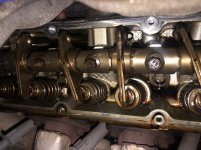Just had to replace a weepy valve cover gasket on the 165k 3.8 Chrysler minivan we bought new in ‘08. I was eager to see what it looked like inside as it’s had PYB 5W20 or 5W30 every 5k since new (one OC early in its life was with M1) along with a P1 filter. At the current mileage it gets one extra quart between changes and is probably a half quart shy of full as 5k rolls around. The engine sounds like new and has no oil leaks apart from the now-changed VC gasket. I was pretty impressed with the internals.
You are using an out of date browser. It may not display this or other websites correctly.
You should upgrade or use an alternative browser.
You should upgrade or use an alternative browser.
PYB - Chrysler 3.8 165k
- Thread starter JeffreyE
- Start date
Looks good 
Looks great! Thanks for the pics.
Looks good, thanks for the pics. Where are you located?
- Joined
- Dec 30, 2006
- Messages
- 29,558
Looks great Jeffery! 
Up until recently I had my first Dodge in decades for over the last decade.
08 Durango 4.7.
I loved that engine, was rock solid, had 155,000 miles on it when we got rid of it last year. Didnt burn or leak oil, amazingly dry of any oil on the outside of the engine. No leaks in transmission either. It impressed me so much that it changed my opinion of the company. Im nit sure when I started to think less of them many years ago and not even sure why the reason.
Here in the South used 5/30 year round even though it called for 5/20. I used almost exclusively "conventional" oil of any of the least expensive brands rated SN. Stuff like Super tech, Sams Club, Chevron ... ect and changed the oil every 4 months. Sometimes 6 months if it wasnt used often as I had a company provided car so at times the truck just sat until the weekends.
08 Durango 4.7.
I loved that engine, was rock solid, had 155,000 miles on it when we got rid of it last year. Didnt burn or leak oil, amazingly dry of any oil on the outside of the engine. No leaks in transmission either. It impressed me so much that it changed my opinion of the company. Im nit sure when I started to think less of them many years ago and not even sure why the reason.
Here in the South used 5/30 year round even though it called for 5/20. I used almost exclusively "conventional" oil of any of the least expensive brands rated SN. Stuff like Super tech, Sams Club, Chevron ... ect and changed the oil every 4 months. Sometimes 6 months if it wasnt used often as I had a company provided car so at times the truck just sat until the weekends.
Most people see a photo sludged up engine from a syn oil ad and automatically think it was the fault of "conventional" oil . 25 years working on i.c. engines and I have never seen a sludged up engine ,But then working fleet type repairs the vehicles are maintained properly.
wemay
Site Donor 2023
Did you replace both valve cover gaskets, or just the one pictured? Wonder if the other head looks any different, since it is operated in higher heat.
Looks good!
PYB has priced itself out at least in my area, unfortunately. More than $18
PYB has priced itself out at least in my area, unfortunately. More than $18
Agreed. I used to use a lot of PYB at 5k changes and it was great. Now I can do 10k full syn oil changes for like 4 bucks more.Looks good!
PYB has priced itself out at least in my area, unfortunately. More than $18
For those who still insist on short OCI's it's still a great choice though.
Just that one. The gasket is a pretty impressive design but while still pliable at the top of the vc near the intake, it had become hard and brittle down near the exhaust. Why would the other head run hotter?Did you replace both valve cover gaskets, or just the one pictured? Wonder if the other head looks any different, since it is operated in higher heat.
Some theorize the reduced airflow on the firewall side of a transverse V engine might cause this. I'm a bit dubious. My daughter has a Chrysler T&C I'll have to check with my heat gun some time.Why would the other head run hotter?
On every V6 minivan I ever worked on the front head always had less varnish than the rear, simply due to the fact that there is a lot less airflow (less cooling of the head) so it ends up "cooking" the oil a bit more in the rear valvetrain area. Front head gets plenty of cooling due to getting some airflow from bumper openings and radiator fans.Just that one. The gasket is a pretty impressive design but while still pliable at the top of the vc near the intake, it had become hard and brittle down near the exhaust. Why would the other head run hotter?
Similar threads
- Replies
- 56
- Views
- 5K


